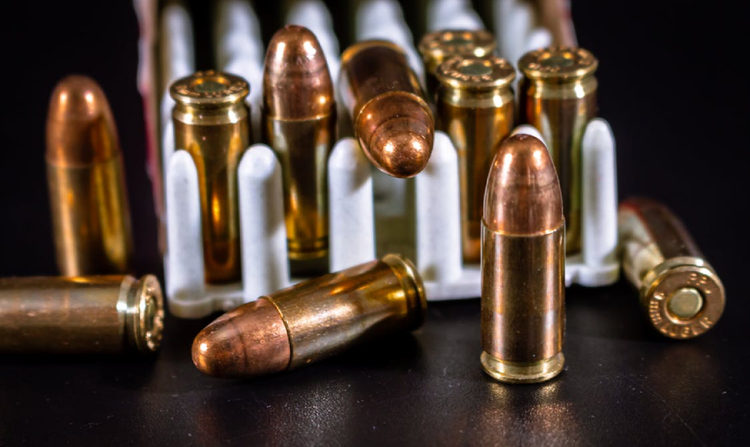If you’re new to shooting, the ammo aisle can look a little intimidating. Shiny brass, copper jackets, boxes labeled with acronyms that sound like government agencies: FMJ, JHP, +P, ACP, and a price tag that makes you wonder if you should’ve just taken up fishing instead.
You don’t want all that noise. Maybe all you want is to fill a piece of paper with holes. Maybe you just want something dead! It doesn’t have to be this complicated, yet here we are, swimming through alphabet soup just to buy a box of cartridges.
Let’s cut through the noise. Today we’re tackling one of the most basic (but most confusing) questions new shooters have: what’s the difference between full metal jacket (FMJ) and jacketed hollow point (JHP) ammo?
One’s for practice, one’s for serious business. But if you stop there, you’ll miss the whole picture, and possibly end up loading your gun wrong for the job.
Full Metal Jacket (FMJ): The Range Rat’s Best Friend
FMJ ammo is basically the Toyota Corolla of bullets: not flashy, but it gets you where you need to go without breaking down. It consists of a lead core wrapped in a harder metal jacket (usually copper or a copper alloy), which keeps the bullet from deforming when it hits targets or feeds through your gun.
Why people love FMJ:
-
Cheap(er). You’re not going to cry every time you squeeze the trigger. Well, not as much.
-
Feeds reliably. The smooth jacket slides through most guns like butter—fewer jams, fewer headaches.
-
Good for practice. It punches holes in paper and knocks over steel plates like a solid wad of metal should.
Why FMJ isn’t ideal for self-defense:
-
Overpenetration. FMJ rounds tend to sail right through targets like they’re applying for TSA PreCheck. That means the bullet can keep going through drywall, doors, or, you know, innocent bystanders.
-
Minimal stopping power. A clean hole is great for leatherworking, not so great when you’re trying to stop a threat.
FMJ is the workhorse round. You buy it by the case, you shoot it until your thumbs hurt from loading magazines, but for self-defense purposes, an FMJ at handgun speeds behaves a lot like a sharp punch: it slips through, leaves a narrow permanent cavity, and keeps going. This is not what you want in a self-defense round. You want something that crushes more tissue, expands rapidly, and mushrooms in such a way that there’s a higher chance of hitting vital organs. For self-defense, you want a hollow point.
Jacketed Hollow Point (JHP): The Business End of Serious Shooting
I like to think that FMJs are for fun and JHPs are for serious business. The tip is hollowed out like a little cup in the nose of the bullet. When it strikes something soft (like ballistic gel or, in defensive scenarios, flesh), the cavity forces the bullet to expand. Expansion creates a bigger wound channel and transfers more energy to the target. Translation: it stops threats more effectively and reduces the chance of your bullet flying through the target and into the neighbor’s drywall.
Why JHP is the self-defense go-to:
-
Expansion = stopping power. Bigger hole, more tissue damage, faster incapacitation.
-
Less overpenetration. Expanding bullets dump energy into the target instead of zipping off like a rogue bottle rocket.
-
Designed for defense. Police, military (where allowed), and concealed carriers use them for a reason.
Why JHP isn’t perfect:
-
More expensive. Buying 500 rounds of JHP for plinking is dumb. They are hunting and self-defense rounds and should be treated accordingly.
-
Can be picky. Some guns don’t feed hollow points as smoothly as FMJs, especially older designs with steep feed ramps.
-
Legal weirdness. A few states have restrictions on hollow point ammo (looking at you, New Jersey). Always check local laws.
Think of JHP as the “serious ammo.” You don’t burn through it on a lazy Saturday; you carry it loaded in your mags when it matters.
Side-by-Side Comparison
|
Feature |
FMJ (Full Metal Jacket) |
JHP (Jacketed Hollow Point) |
|
Cost |
Cheap(er), great for bulk practice |
Pricey—save for carry and defense |
|
Purpose |
Range practice, training, plinking |
Self-defense, duty use, hunting small/medium game |
|
Penetration |
Deep, often too much |
Controlled, less risk of overpenetration |
|
Stopping Power |
Meh. Punches clean holes |
High. Expands and transfers energy |
|
Reliability |
Extremely reliable feeding |
Can be finicky in some firearms |
|
Legality |
Legal everywhere |
Restricted in a few states |
The “Train With FMJ, Carry With JHP” Rule
This is the golden rule for most shooters:
-
Buy FMJ in bulk and use it to drill fundamentals—grip, stance, trigger control.
-
Carry JHP in your defensive firearm.
Think of it like shoes: you’ve got your beat-up sneakers for mowing the lawn (FMJ) and your decent boots for when you actually need to look respectable (JHP). Both have a place, but you wouldn’t wear grass-stained running shoes to a job interview.
A Note on Caliber
Some beginners get hung up on FMJ vs JHP without realizing caliber matters just as much. A .22LR hollow point is still a .22LR, which means it’s better than harsh language, but not ideal for defense. A 9mm JHP is considered the baseline for concealed carry, while .40 and .45 fans will tell you bigger is always better (and argue about it endlessly on the internet). As for yourself, pick a caliber you can shoot accurately, then pair it with the right bullet type.
Final Thoughts
At the end of the day, FMJ and JHP aren’t rivals in some cage match—they’re tools for different jobs. FMJ is your cheap, reliable buddy for range day. JHP is the sharp suit you keep in the closet for court dates and funerals—except in this case, hopefully the other guy’s.
New shooters: don’t overcomplicate it. Train with FMJ. Carry with JHP. Don’t mix them up. And if you can’t remember which is which, just look at the tip: if it’s flat and boring, it’s FMJ. If it looks like someone started a pothole in the nose, it’s JHP.
Congratulations—you now know more about ammo than the guy stepping into the gun store for the first time.
Frequently Asked Questions
Can I carry FMJ for self-defense?
You can, but it’s not recommended. FMJ is better than nothing, but if you need to stop a threat quickly, JHP is the smarter choice.
Can I practice with JHP?
Sure, if you like burning money. Some people run a mag or two of their carry ammo at the range just to confirm reliability. But for day-to-day training, stick with FMJ.
Do I need to sight in differently with FMJ vs JHP?
Not usually, but different loads (weight, velocity, brand) can shift your point of impact. Pro tip: test your carry ammo at the range so you know exactly where it hits.
Are hollow points legal?
Most of the U.S.? Yes. Certain states? Nope. Always double-check, because “I didn’t know” is not a valid legal defense.

